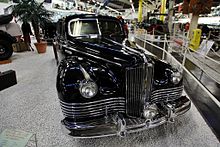ZIS-115
| ZIS-115 | |
|---|---|
 | |
| Overview | |
| Manufacturer | ZiS |
| Production |
|
| Body and chassis | |
| Class | Armored limousine |
| Body style | 4-door sedan |
| Layout | FR layout |
| Related | ZIS-110 |
| Powertrain | |
| Engine | 6.0L ZIS-115 I8 |
| Transmission | 3-speed manual |
| Dimensions | |
| Wheelbase | 3,760 mm (148.0 in) |
| Length | 6,000 mm (236.2 in) |
| Width | 1,960 mm (77.2 in) |
| Height | 1,730 mm (68.1 in) |
| Curb weight | 4,200 kg (9,259 lb) |

The ZIS-115 is a Soviet-built, armored version of the ZIS-110 limousine, designed and built especially for Joseph Stalin.[1] 32 of the cars were manufactured between 1948 and 1949. The heavily armored car's design was based on the American 1942 Packard Super Eight. The car weighed over 4 tonnes, windows made of glass nearly 8 cm (3 in) thick (each of which weighed over 200 kg (441 lb)) were powered by a hydraulic system. Its 6.0-liter (5,998 cm3 (366 in3)) straight-eight engine (an upgraded version of the ZIS-110 engine) generated 162 horsepower with a top speed of 121 km/h (75 mph). Stalin, extremely paranoid of assassination, always rode in the rear of the car, seated between two armed bodyguards. He never rode in the same armored ZIS two days in a row, and frequently changed the route driven from his home in Kuntsevo to the Kremlin. Usage of this vehicle was seen in other countries, as Stalin donated a ZIS-115 to Chairman Mao Zedong due to the lack of armored Chinese vehicles suitable for the purpose of transporting high-ranking officials.[2] After Stalin's death in 1953, the armored ZIS limousines continued to be used for many years by successive Soviet leaders. Today, several of the cars still exist and are owned by private collectors and museums around the world. Russian leaders had some in their official garage until 1994.
References[edit]
- ^ Siegelbaum, Lewis H. (2011-08-15). Cars for Comrades: The Life of the Soviet Automobile. Cornell University Press. p. 27. ISBN 978-0-8014-6148-4.
- ^ Li, Anding (2021-12-02). Decoding China's Car Industry: 40 Years. World Scientific. p. 46. ISBN 978-981-12-4112-3.
